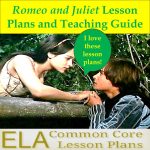I love irony. I once stayed awake all night thinking about how ironic things were. I finally concluded that everything was ironic, which in itself was ironic because not everything is ironic.
What’s ironic is I wrote this blog post before realizing I could just provide a pdf download.
Irony Explained
First things first: get to know these basic definitions of irony.
1. Irony - The difference between what someone would reasonably expect to happen and what actually does.
2. Situational Irony - When one’s efforts produces the opposite results of what was expected
- Romeo and Juliet Example: Romeo’s attempt to establish peace between Mercutio and Tybalt leads to Mercutio’s death and an escalation of the family war.
- Historical Example: Surrendering guards at the Bastille still managed to kill 98 citizens.
3. Verbal Irony - A contrast between what is said and what is actually meant
- Romeo and Juliet Example: After Romeo kills Tybalt and is banished, Juliet tells her mother how she wishes she could go to Romeo that evening. Her mom thinks Juliet wants to find Romeo and kill him. What she really means is she wants to go to him and enjoy intimate marital relations.
- Literary Example: Prometheus says to Zeus, “You are as kind as you are wise.” Zeus thinks it’s a compliment. Because Prometheus doesn’t think Zeus is wise, it’s actually an insult.
4. Dramatic Irony - When the audience knows things the characters do not
- Romeo and Juliet Example: We know Juliet has taken a sleeping potion. Everyone else, except Friar Lawrence, thinks she is dead.
- Romeo and Juliet Example: We know Juliet has married Romeo. The Capulets and Paris do not.
- Literature Example: In Horton Hears a Who, we know that Horton really is talking to little people on a bubble, but everyone else thinks he’s crazy.
Irony Lesson Plan Procedures

Click the pic and check out the 8-12 week Romeo and Juliet unit plan and teaching guide.
The following lesson plan can be used at any point in the play.
Warm up: Have students copy a chart. The chart should include four columns. Each column should contain the following titles:
- Specific Example of Irony (Act, scene, lines)
- Verbal Irony
- Situational Irony
- Dramatic Irony
Include as many rows as you think necessary. I recommend at least five.
- Instruct students to copy the definitions of irony on the back of their chart. Discuss irony and provide examples. Persuade students to provide examples.
- Instruct students to find five examples of irony from the play, a particular act, scene, or lines. Have them identify the type of irony and explain how it’s ironic. The explanation should be written in the appropriate column in the chart.
- After the chart is filled out, assign a literary analysis analyzing irony.
Sample
Specific Example of Irony
1. All weep for Juliet’s death.
Dramatic Irony
We all know that Juliet has taken a potion to fake death. This build’s suspense.
ELA Common Core Standards Covered
This writing activity satisfies the following Common Core Standards.
- Common Core Writing Standard 1. Write arguments to support claims in an analysis of substantive topics or texts, using valid reasoning and relevant and sufficient evidence. W.9-10.5 Develop and strengthen writing as needed by planning, revising, editing, rewriting, or trying a new approach, focusing on addressing what is most significant for a specific purpose and audience. (Editing for conventions should demonstrate command of L.9-10.1-3.)
- Common Core Writing Standard 2. Write informative/explanatory texts to examine and convey complex ideas, concepts, and information clearly and accurately through the effective selection, organization, and analysis of content.
- RL.9-10.1 Cite strong and thorough textual evidence to support analysis of what the text says explicitly as well as inferences drawn from the text.
- RL.9-10.2 Determine a theme or central idea of a text and analyze in detail its development over the course of the text, including how it emerges and is shaped and refined by specific details; provide an objective summary of the text.
- RL.9-10.4 Determine the meaning of words and phrases as they are used in the text, including figurative and connotative meanings; analyze the cumulative impact of specific word choices on meaning and tone (e.g., how the language evokes a sense of time and place; how it sets a formal or informal tone).
- L.9-10.3 Apply knowledge of language to understand how language functions in different contexts, to make effective choices for meaning or style, and to comprehend more fully when reading or listening.
- L.9-10.5 Demonstrate understanding of figurative language, word relationships, and nuances in word meanings.
- L.9-10.5a Interpret figures of speech (e.g., euphemism, oxymoron) in context and analyze their role in the text.
- L.9-10.5b Analyze nuances in the meaning of words with similar denotations.
Romeo and Juliet Lesson Plans
Students will respond positively to Romeo and Juliet if they are engaged.
- Strategies for Analyzing Shakespeare
- Romeo and Juliet Cause and Effect Lesson Plan
- Teaching Characterization with Romeo and Juliet
- Romeo and Juliet Shields
- Character Interview
- Romeo and Juliet Writing Activity
- Romeo and Juliet Irony Lesson Plan
